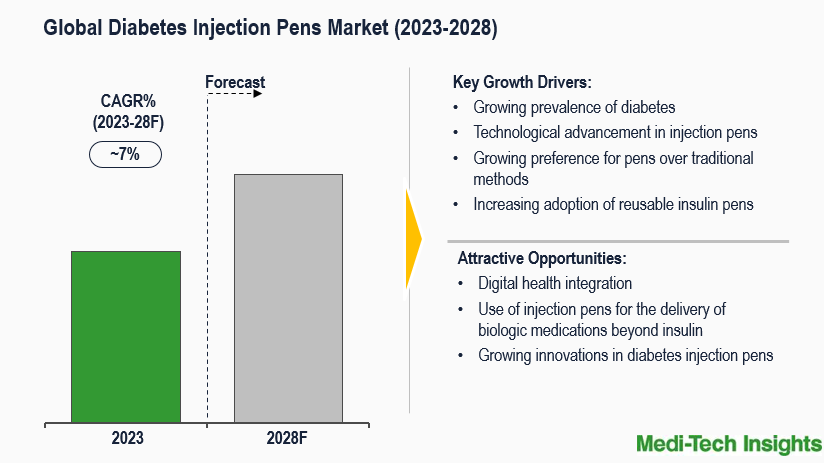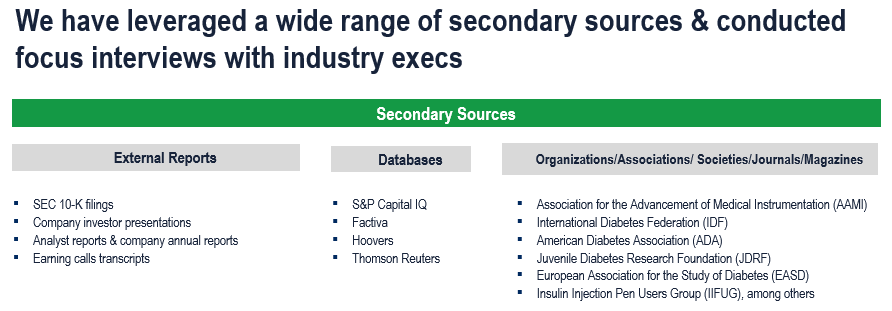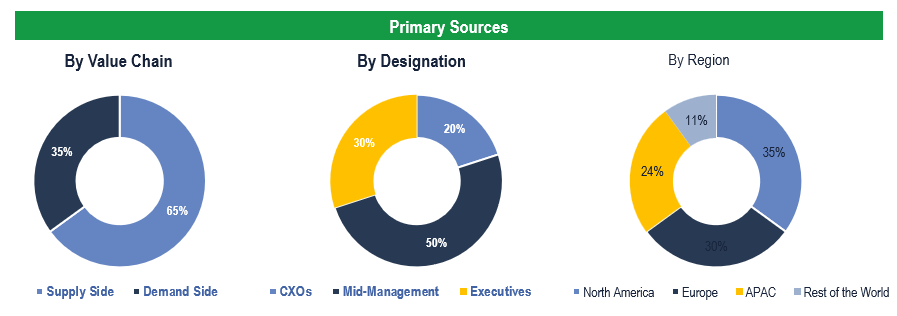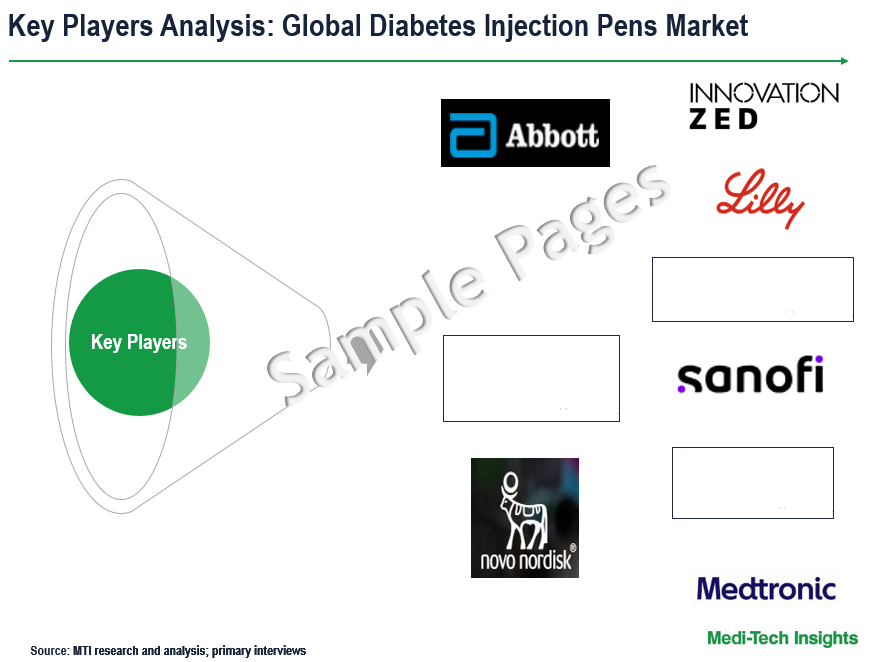
Diabetes Injection Pens Market: Global Industry Analysis, Market Share, Size, Trends and Forecast to 2028
The Diabetes Injection Pens Market is expected to witness a growth rate of ~7% by 2028. The key factors driving the market are the rising prevalence of diabetes, the growing preference for pens over traditional methods, the increasing adoption of reusable insulin pens, technological advancement in injection pens, the growing integration of injection pens with diabetes care technologies, and the growing demand for connected insulin pens. To learn more about the research report, fill out a quick inquiry for a sample report.
Diabetes injection pens are innovative medical devices designed for administering insulin to individuals with diabetes. These pens, preloaded with insulin cartridges, provide a convenient and precise method for insulin delivery. Offering needle-safe features, they play a crucial role in managing insulin doses effectively, enhancing the quality of life for those with diabetes. There are two main types of insulin pens: disposable insulin pens and reusable insulin pens:
- A disposable insulin pen: Contains a prefilled insulin cartridge. Once used, the entire pen unit is thrown away.
- A reusable insulin pen: Contains a replaceable insulin cartridge. Once empty, a person discards the cartridge and installs a new one
Benefits Associated with Using Diabetes Injections Pens Boost the Market Growth
Insulin plays a key role in treating Type 1 and Type 2 Diabetes. Currently available insulin delivery systems for insulin administration include insulin syringes, insulin infusion pumps, jet injectors, and insulin pens. Diabetes injection pens offer several benefits over traditional methods like vials and syringes, making them a preferred choice for many individuals managing diabetes. Some of the advantages include:
- Convenience & Portability: Injection pens are compact, lightweight, and easy to carry, providing users with increased portability. This also makes it easy for individuals to inject themselves if they are away from home
- Ease of Use: Injection pens are designed for simplicity, making them user-friendly for individuals with varying levels of agility and vision
- Pre-filled cartridge: Many injection pens come with pre-filled insulin cartridges, eliminating the need for users to draw insulin from vials. This pre-filled feature simplifies the injection process, reducing the risk of dosage errors and contamination
- Dose Accuracy: Doses are easily dialed. This reduces the risk of dosing mistakes. Injection pens typically offer more accurate dosing compared to traditional methods. The devices allow users to dial precise insulin doses, providing better control over insulin administration and improving overall treatment accuracy
- Reduced Needle Anxiety: Diabetes injection pens are particularly beneficial for individuals who may have a fear of needle
- Less Painful Injection: The design of injection pens, including the use of finer needles and controlled injection speed, can result in less painful injections. This may improve the overall experience for individuals who need to inject insulin regularly.

Fill out the "Quick Inquiry Form" to request a sample copy.
Growing Adoption of Smart Insulin Products Drives Market Growth
Smart insulin pens represent a significant leap forward in diabetes care, leveraging cutting-edge technology to enhance precision, convenience, and data management in insulin delivery. These innovative devices integrate connectivity features, digital interfaces, and data tracking capabilities, empowering individuals with diabetes to take control of their insulin management with greater ease and insight. Smart insulin pens are equipped with Bluetooth technology, enabling seamless communication with mobile applications and other digital devices. Smart pens often come with built-in dose memory features, ensuring that users can easily track the time and dosage of their last insulin injection. Moreover, they can be paired with apps that provide data from blood glucose meters as well as flash and continuous glucose monitors (CGM), so glucose and insulin dosing data can be stored in one place. As smart insulin pens continue to evolve, incorporating artificial intelligence and machine learning capabilities, the future holds the promise of even more advanced and personalized solutions for individuals living with diabetes. For instance,
- In September 2023, Abbott announced that they had agreed to acquire Bigfoot Biomedical, a company that makes smart insulin pen caps that can sync with continuous glucose monitors to provide dose recommendations. Bigfoot’s smart caps can be used with both long-acting and rapid-acting disposable insulin pens made by the three major insulin manufacturers
- In March 2022, Novo Nordisk announced the launch of its smart insulin pens in the UK, providing diabetes patients within the NHS access to devices that can monitor and record dosing information
Diabetes Injection Pens Market: Covid-19 Impact
During the COVID-19 pandemic, the need for diabetes injection pens has seen a consistent uptick, driven by a proactive approach to managing glucose levels and minimizing complications in individuals with diabetes. Considering, that diabetic patients are more likely to have serious complications from COVID-19 which include effects on glucose homeostasis, inflammation, altered immune status, and activation of the renin-angiotensin-aldosterone system (RAAS), thus the importance of continuous glucose monitoring for this population becomes paramount. The pandemic has also catalyzed advancements in digital, interconnected diabetes care, and personalized treatment approaches. This acceleration in healthcare trends is anticipated to fuel the adoption of diabetes injection pens in the market. The heightened awareness of the vulnerabilities of individuals with diabetes during the pandemic has underscored the significance of effective and user-friendly insulin delivery methods, contributing to the increased demand for these innovative devices.
Diabetes Injection Pens Market: Key Constraints/ Challenges
Insulin pens are more expensive than traditional syringes. Reimbursement issues in some regions pose challenges to market growth. Additionally, the need for proper education and training for patients to use injection pens effectively is an ongoing concern. Some insulin formulations used in injection pens may require refrigeration, posing a challenge for individuals without consistent access to refrigeration or those who travel frequently. Also, patients who are accustomed to traditional insulin delivery methods, such as vials and syringes are resistant to adopting new technologies like insulin pens.
North America Expected to Continue to Hold a Major Share in the Diabetes Injection Pens Market
From a geographical perspective, North America holds a major market share of the diabetes injection pens market. This can be mainly attributed to the growing prevalence of diabetes, growing adoption of technologically advanced products, rising awareness regarding diabetes self-management solutions, rising cases of obesity, less physical activity, and unhealthy food habits in the region. However, the Asia-Pacific region is expected to witness strong growth in the coming years due to a large diabetic & pre-diabetic patient pool, growing health concerns, rising awareness regarding diabetes care, and adoption of advanced insulin delivery systems in the region.
Diabetes Injection Pens Market: Competitive Landscape
Some of the key players operating in the market include Medtronic Plc, F.Hoffmann-LA Roche Ltd, Eli Lily & Company, Ypsomed, Novo Nordisk, Innovation Zed, Sanofi, Merck, AstraZeneca, Owen Mumford Ltd, Terumo Medical Corporation, Braun Medical, Sun Pharmaceutical Industries Ltd., Biocon, and Becton Dickinson and Company, among others.
Organic and Inorganic Growth Strategies Adopted by Players to Establish Their Foothold in the Market
Players operating in this market are adopting organic and inorganic growth strategies such as launching new products, acquiring related firms, and entering into collaborations to garner higher market share. For instance,
- In April 2023, Innovation Zed, an Irish R&D company specializing in the design and development of innovative medical devices entered into a partnership with GluCare.Health, a leading metabolic disease management platform, provides connected insulin pen technology as part of a combination product in GluCare.Health’s Digital Clinic Ecosystem
- In March 2023, Novo Nordisk announced that the company would drop prices for vials and pens of NovoLog and other insulin brands by 75 percent beginning January 1, 2024, in the United States. There is expected to be a 65 percent price reduction for some of the other Novo Nordisk insulin brands
- In April 2022, Abbott entered into a partnership with CamDiab and Ypsomed. Under the terms of the partnership, the three companies plan to develop and commercialize an integrated automated insulin delivery (AID) system that is expected to lessen the difficulties of round-the-clock diabetes management for people with diabetes
- In March 2022, Novo Nordisk announced the launch of its first smart insulin pens. The Novo-Pen Echo Plus and Novo-Pen 6 are insulin self-injection pens that collect data such as how much and when insulin is injected. The data is then uploaded to an app through a near-field communication (NFC) link so that healthcare professionals and patients may examine it
The diabetes injection pens market is a growing market that is expected to gain further momentum in the coming years due to a strong emphasis on developing new products, innovations in diabetes care technology, increasing awareness regarding diabetes self-management and care, and aggressive organic and inorganic growth strategies followed by the players.
Key Strategic Questions Addressed
- What is the market size and forecast for the Diabetes Injection Pens Market?
- What are the historical, present, and forecasted market shares and growth rates of various segments and sub-segments of the Diabetes Injection Pens Market?
- What are the major growth drivers, restraints/challenges impacting the market?
- What are the opportunities prevailing in the market?
- What is the investment landscape?
- Which region has the highest share in the market? Which region is expected to witness the highest growth rate in the next 5 years?
- Who are the major players operating in the market? What is the competitive positioning of key players?
- Who are the new players entering the market?
- What are the key strategies adopted by players?
- Research Methodology
- Secondary Research
- Primary Research
- Market Estimation
- Market Forecasting
- Executive Summary
- Market Overview
- Market Dynamics
- Drivers
- Restraints
- Opportunities
- Industry Speaks
- Market Dynamics
- Global Diabetes Injection Pens Market - Size & Forecast (2021-2028), By Product
- Reusable Injection Pens
- Disposable Injection Pens
- Global Diabetes Injection Pens Market - Size & Forecast (2021-2028), By End User
- Hospitals & Diagnostics Clinics
- Home Care Settings
- Others
- Global Diabetes Injection Pens Market - Size & Forecast 2021-2028), By Region
- North America (U.S. & Canada)
- Europe (UK, Germany, France, Italy, Spain, Rest of Europe)
- Asia Pacific (China, India, Japan, Rest of Asia Pacific)
- Rest of the World (Latin America, Middle East & Africa)
- Competitive Landscape
- Key Players and their Competitive Positioning
- Competitive Positioning of Key Players (2022)
- Offerings Assessment, By Players
- Key Strategies Assessment, By Player (2021-2023)
- New Product Launches
- Partnerships, Agreements, & Collaborations
- Mergers & Acquisitions
- Other Developments
- Key Players and their Competitive Positioning
- Key Companies Scanned (Indicative List)
- Novo Nordisk A/S
- Medtronic plc
- Becton, Dickinson and Company
- Sanofi
- Eli Lilly and Company
- Merck
- AstraZeneca
- Hoffmann-La Roche Ltd.
- Owen Mumford Ltd
- Ypsomed
- Terumo Medical Corporation
- Other Prominent Players
The study has been compiled based on extensive primary and secondary research.
Secondary Research (Indicative List)

Primary Research
To validate research findings (market size & forecasts, market segmentation, market dynamics, competitive landscape, key industry trends, etc.), extensive primary interviews were conducted with both supply and demand-side stakeholders.
Supply Side Stakeholders:
- Senior Management Level: CEOs, Presidents, Vice-Presidents, Directors, Chief Technology Officers, Chief Commercial Officers
- Mid-Management Level: Product Managers, Sales Managers, Brand Managers, Business Development Managers, Consultants
- Demand Side Stakeholders: Hospital and Diagnostics Clinics, and Home Care Settings, Among Others
Breakdown of Primary Interviews

Market Size Estimation
Both ‘Top-Down and Bottom-Up Approaches’ were used to derive market size estimates and forecasts.
Data Triangulation
Research findings derived through secondary sources & and internal analysis were validated with Primary Interviews, an Internal Knowledge Repository, and Company Sales Data.



